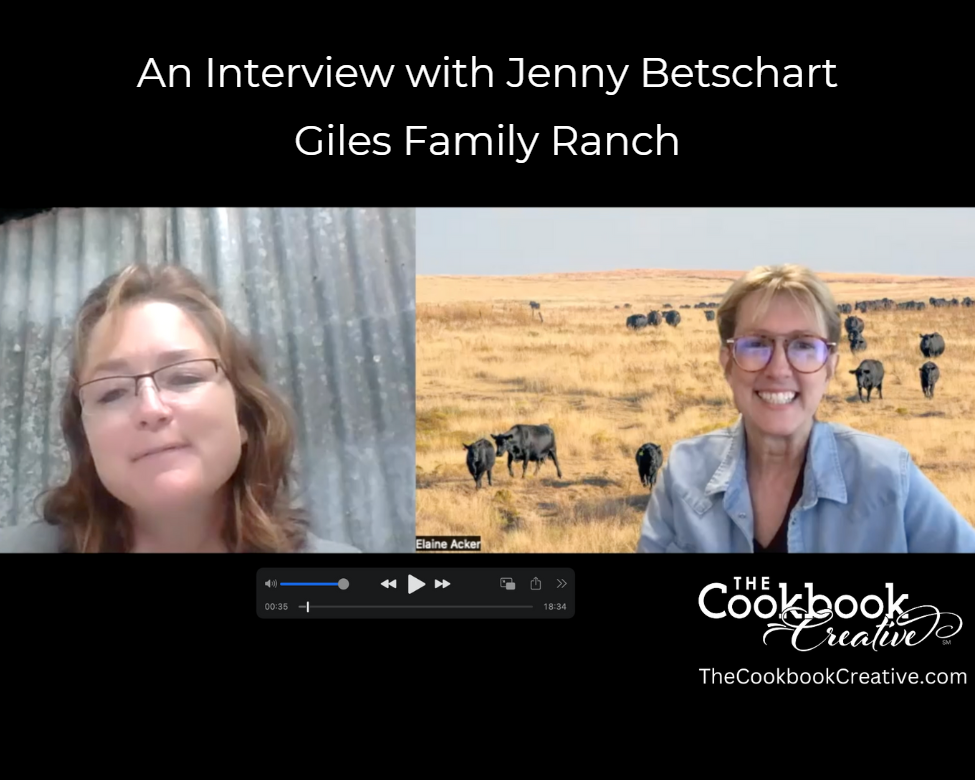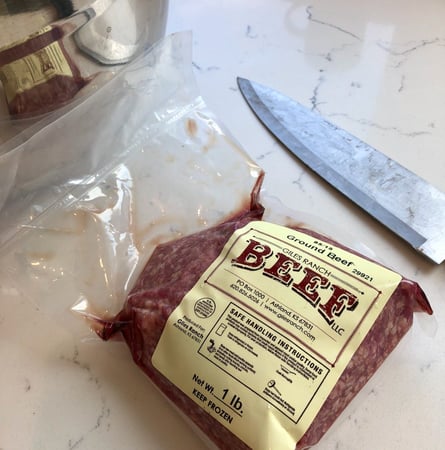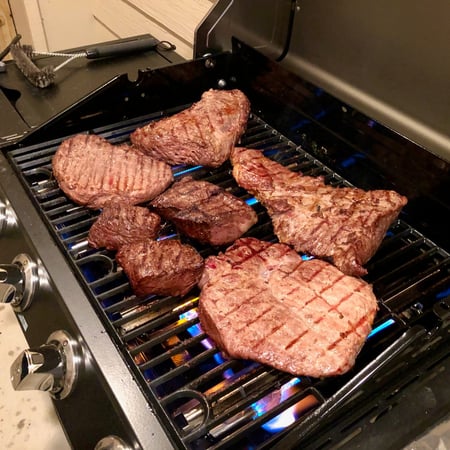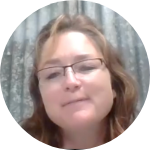
Giles Family Beef Ranch: An Interview with Jenny Betschart
Elaine Acker
Welcome! Today, we’re going to visit with Jenny Betschart. Jenny and two of her sisters are now running the Giles family beef ranch in Kansas. And beef is one of my favorite topics.
Elaine: Welcome, Jenny. Tell me what it’s like to run the ranch and to run it with your sisters.
Jenny: Thank you for having me today. We really enjoy ranching. We love cattle. We love being able to raise our kids together, getting to work together every day. It is just a really great life and a lifestyle that we chose, and we’re very thankful that we were able to do it.
Elaine: And you all get along?
Jenny: That we do. I mean, any family business, anybody that’s in a family business knows there’s ups and downs. But we are very focused on using each other’s strengths. Each of us brings different strengths to the table. We’re good at delegating and sharing tasks, whether that be the day-to-day operations, bookkeeping, genetics, or marketing — it’s a whole range of things that we’re all able to share together. And we are working moms, so we take care of each other’s kids a lot as needed and just really enjoy working together.
Elaine: And just so everybody knows, I have a personal connection to this family. Megan Giles is another sister, and she is The Cookbook Creative’s graphic designer. So all the beautiful new cookbooks that we produce are designed by Megan. So they’ve also got some graphic design skills in the family mix.
Jenny: We do. We rely on Megan a lot. She helps us with our website with any graphic design work we have here at our store and. T-shirts, coffee mugs, just all sorts of different things she’s helped us with.
Elaine: I’m kind of addicted to her t-shirts.
...So, talk to me a little bit about the beef industry and ranching. How has that changed over the last few years?
Jenny: I guess one of the changes over the last few years is that as COVID hit and grocery store shelves became very empty, lots of people chose to seek more stability by buying locally. And so that enabled us in 2020 to open up a beef store here in Ashland, Kansas. Our town is really small. There’s only 750 to 800 people here. So the opportunity to grow probably isn’t as good as if we were in a larger area. But with online marketing, we’re able to ship quite a bit of beef kind of throughout the lower 48 states.
Elaine: Yes! And I’ve had some of that beef, and it’s delicious.
Jenny: Thank you.
Elaine: When you mentioned a stable food supply, it made me think of the word “sustainability” as well. And you hear the two sides of the coin with traditional beef vs. all of these new plant-based products. How has that impacted your business, if at all?
Jenny: I don’t know that it’s really impacted us directly, but I would hope that consumers are looking at what you’re putting in your body. Do you want to put in a protein such as beef, chicken, pork, something that is natural and comes directly from the source versus a plant-based protein that’s got so many ingredients? And if you aren’t wanting to eat meat, just don’t eat meat. But if you’re going to eat the fake stuff, I just really feel like that probably isn’t m something that’s going to be healthy or good for your body in the long term.
Elaine: It’ll be it’ll be interesting to keep an eye on that as that market develops and changes. And then the drought has been interesting this last year. So what was the impact of the drought on your ranch and on other ranching families?
Jenny: I think we’re seeing the biggest, heaviest hit part of the drought hitting right now as we go into fall. Fall is when we should be planting wheat for wheat pasture. We should be weaning calves in October. We’re weaning them now in September, weaning early. And we’re going to have to sell quite a large chunk of our herd this fall. There’s no moisture in sight.
Elaine: I hate to hear that. And I hope y’all you’ll find a way to manage through it. It sounds like you’ve got a plan.
Jenny: We do. We have a good plan. And drought is just part of ranching. So, while it is tough to go through it and not something anybody wants to do if you’re in agriculture, you just know that Mother Nature is not always going to be on your side.
Elaine: Yes. And that kind of planning comes with being in touch, not just with where your food comes from, but like you say, with nature itself and how some of these cycles impact what you harvest.
Jenny: Right.
Elaine: You run black angus cattle, correct?
Jenny: Yes. That’s what we raise.
Elaine: Tell me about how you feed the cattle and how that affects the flavor of what we get and put on the grill.
Jenny: The life cycle of a calf on our ranch is they would be born in February or March and run with their mom drinking their mom’s milk, eating grass, eating some protein supplements through September, or October. And that’s when they’re weaned. And depending on what feed sources we have available, we try to wean them on grass. Sometimes they’re weaned on a ration, which would include hay and grain and a mineral supplement. They’ll run beyond that for the next 2 to 3 months and then in anywhere, depending on their size and age from December through May, we will place them in a commercial feed yard. Right now, we use a feed yard owned by my sister’s husband and his family. And they’ll go there for the next 140 to 170 days where they’ll be on a very healthy, fresh ration of that consists of hay, grain, mineral, a vitamin package and always access to clean fresh water. At the point that they’re finished and ready for harvest, our cattle are harvested in two different places.
We use a place in Kiowa, Kansas, that is a USDA inspected facility. For us to be able to ship out of state, it has to be USDA inspected. And then we also recently started using one that’s a little bit closer to home called Meat Locker. It’s a state inspected facility that still meets the same standards as a USDA inspected facility. They just don’t have the USDA stamp, so it can’t be shipped out of state.
Elaine: And so once you’re done with the harvest and you’re starting to get the cuts that you sell, what are what are you trying to achieve with these cuts? Is there a certain amount of marbling? How is that what you fed the cows now affecting the quality of the beef?
Jenny: Two big things affect the quality of our beef. One is genetics. We are always trying to use bulls that are going to add marbling and growth to our calves. We want to also balance that with cows that are going to have good maternal traits and good milking, but not too much milk, because that means a cow would be harder to keep. It’s always kind of a balancing act.
That’s what my sister Katie does. And so genetics play a huge difference in that on the size of the steak, the marbling that you see. Then the other part of that would be the feed that they receive. We choose to grain feed because we feel like that helps evenly distribute the marbling better, just has a better marble, better flavor, better quality beef that our customers enjoy that we as a family enjoy. And while grass finished is also a great option, if that’s something you prefer, we, our family really prefers the taste of grain fed, and we’re trying to sell something that we want to eat.
Elaine: I love that you’re not selling anything that you’re not personally eating yourself.
...Can you describe how that’s different from what we typically see at the grocery store?
 Jenny: So what you see at the grocery store is still very safe, very healthy beef that’s been raised on most likely a family farm or ranch because the majority of cattle are. But what’s different about it is it may be a lower quality. Maybe those ranchers didn’t put the investment into genetics that we have. And so you can see that in the price.
Jenny: So what you see at the grocery store is still very safe, very healthy beef that’s been raised on most likely a family farm or ranch because the majority of cattle are. But what’s different about it is it may be a lower quality. Maybe those ranchers didn’t put the investment into genetics that we have. And so you can see that in the price.
We’re spending a lot more on our bulls than some other ranches are, but we’re also selling our beef for more than they are. So, what you would pay for a steak at Walmart is going to be vastly different than what you would pay for a steak in our store, but the quality difference would definitely be there as well.
Elaine: Now that we’re at the steak part of this conversation…
Jenny: We love steaks.
Elaine: What is your favorite cut?
Jenny: My favorite cut would be either a ribeye or filet. Those are just hands down, full of flavor and marbling. We also love we skirt steak and flat irons at our house. We had flat iron this weekend that you could have cut with a butter knife. They just were so tender and flavorful. And then my favorite other cut — I love roast. We eat a lot of roast just because it’s easy and quick to feed a family that way. Something you can put in the crockpot in the morning and have ready that night for supper.
Elaine: Is there any particular way you like your roast cooked?
Jenny: I have two different ways that I very much love. One is the Mississippi pot roast recipe off of Pinterest. You put a frozen roast in the crock pot in the morning. You top it with a stick of butter, a packet of aujus, a packet of dry ranch dressing, and 5 to 10 pepperoncini peppers. You don’t need to add water. It cooks in its own juice. Cook that on low for 10 to 12 hours, and then we shred it and eat it with mashed potatoes or in French dip sandwiches — however you eat it, it’s amazing.
And then my mom and grandma both cooked another favorite roast recipe. You take a flatter roast, like an arm roast. It would be probably one and a half to two inches thick. And you use an electric skillet. Liberally salt the bottom of your electric skillet with salt, turn it on high, and brown both sides of the roast. Once both sides are browned, you add in onions, carrots, and potatoes, in a cup or two of water. Then, just turn it to low and cook it for 4 to 5 hours.When you get it done, it’s brown and gooey on the bottom. The vegetables are delicious. The beef is delicious. It’s what we traditionally had for Sunday dinner because it was you could cook it in the morning and it was done by lunchtime.
Elaine: Nice. One more product you carry is beef bacon?
Jenny: We do. We’ve had that for three, four or five years now. It it’s kind of a specialty, but it comes from the same area in the belly as pork bacon. It’s cooked, smoked the same, cured the same, and just has a little bit different flavor profile. It’s a little bit deeper, richer flavor. We love it, especially on pizza. We started making a pizza with a really, really thin flatbread and then we coat it with some type of soft cheese. Lots of times we use goat cheese, arugula, crumbled beef, bacon, and then we drizzle it with Hot Honey. And it is amazing.
Elaine: Hot as in warmed up hot?
Jenny: No, it’s called Hot Honey. And so it’s got some chili peppers in it. Spicy, spicy honey. Wow.
Elaine: What is in your refrigerator that would surprise me.
Jenny: Today? Probably nothing! It has been a crazy, crazy two weeks of back to school. We are eating at ballgames and convenience stores right now. I think we have a little bit of ham left maybe for sandwiches and then it’s pretty slim pickings.
Elaine: What’s your favorite ballgame food?
Jenny: There’s not a lot of choices here in Kansas, so it’s burgers or hot dogs. Usually, we choose burgers.
Elaine: What do you wish people knew about ranchers or ranching?
Jenny: I hope that everyone knows and understands that ranchers are the original environmentalists. We are stewards of the lands. We make our living off of taking care of the land. If we don’t take care of it, it will not take care of us. And we cannot live make a living off of it if we abuse it. So, with all the kind of misinformation out there about cows being bad for the environment and people not taking care of the land, yes, there’s always going to be some a few bad people that don’t do things right. But for the most part, farmers and ranchers want to take care of the land. It’s a way of life that we’ve chosen. It’s something we want to be able to pass on to our children and grandchildren. So it’s of utmost importance to us to take care of it.
Elaine: How do people get in touch with you and buy from you?
Jenny: Anyone can buy online from us through our online store: GilesRanch.com. We ship weekly anywhere in the lower 48. We also have our store called the Meating Place on Main Street in Ashland, Kansas. So if you’re ever in our area, we would love for you to stop by!
We have individual cuts of beef or we also sell halves and whole beef. We also carry a little bit of locally raised pork, chicken, and lamb, along with candies and jellies and cookies and fun treats that are also made locally.
Elaine: All the yummy goodies from Kansas.
![]()
Jenny: We try!
Elaine: And it was great to talk to you. And I have to go cook a steak now!

